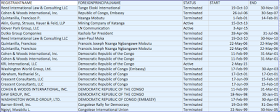Après multiples rebondissements, le sénat a
enfin adopté, la semaine dernière, le projet de loi portant répartition des
sièges par circonscription pour les élections locales et municipales. Non sans
déchirements additionnels au sein de la classe politique congolaise.
Entre les dispositions de la constitution en
matière des sessions extraordinaires et le règlement intérieur de la chambre
haute, la pression a été telle que Léon Kengo wa Dondo a dû lâcher, afin d’éviter
au sénat la réputation qui lui était faite «d’empêcheur de glisser en rond», et
à lui-même l’accusation infamante de celui par lequel le scandale risquait d’arriver !
Il reste qu’en faveur d’un fonctionnement sain
de la démocratie, la Cour Constitutionnelle aurait dû être sollicitée afin
d’interpréter les textes controversés. Le message de la majorité, en
l’occurrence, s’est voulu plutôt belliqueux en direction d’autres forces
politiques et sociales du pays : se coucher ou ne pas exister. Une posture d’autant plus paradoxale que si
elle permet, certes, de rêver à la tenue
d’élections locales dans un horizon encore incertain, elle n’offre toujours
pas, au même moment, la capacité d’avoir
à la fois la maîtrise du temps, des moyens financiers et du fichier électoral.
Le glissement se trouvait ainsi inscrit dans l’ADN d’une démarche qui reste,
pour beaucoup de Congolais et leurs partenaires, contestable dans son principe.
L’empressement de la majorité pose en effet,
au stade actuel, deux questions majeures à la classe politique congolaise
ainsi qu’aux partenaires dans le processus électoral. La première relève de la
problématique constitutionnelle : que deviennent, dans cette course, les
nouveaux majeurs, dont le sort avait récemment «ému» même le chef de l’Etat, au
point de l’amener, dans son adresse du 30 juin, à souhaiter que le dialogue
permette, entre autres, de trancher en faveur de leur enrôlement. Aucun texte
n’autorise, en effet, qu’une institution, un individu ou groupe d’individus,
empêche des citoyens à part entière d’exercer leur devoir civique.
La deuxième question est d’ordre politique. Le
découpage des provinces a en effet redistribué les circonscriptions électorales
sur l’ensemble du territoire national. Mais au-delà de ce redéploiement, il
restera encore et toujours l’épineuse question de la redistribution du corps
électoral – la fameuse cartographie - face au phénomène du nombre élevé des
bureaux de vote dans certains territoires à faible démographie, comparativement
à leur nombre relativement bas dans les territoires à plus forte densité
démographique.
Pour qu’elle ne soit pas évacuée juste comme
un simple détail, rappelons que cette question avait empoisonné le débat au
lendemain des élections de 2011. Avec, d’un côté, des bureaux de vote ayant
connu un taux de participation de plus de 100%, sans aucune explication
cohérente et, de l’autre, un taux de participation différent d’un scrutin à
l’autre entre la présidentielle et les législatives dans un même bureau et pour
des élections couplées. Plus généralement, les Missions d’Observation
Electorales s’étaient montrées très dubitatives, sinon critiques, sur des taux
de participation extrêmement élevés dans les zones favorables à la majorité et
très bas dans celles où c’est l’opposition qui avait les faveurs.
Autant dire que l’empressement à aller coûte
que coûte aux élections locales sans avoir enrôlé les nouveaux majeurs, sans un
audit fiable du fichier électoral et sans un redéploiement conséquent de la
cartographie des bureaux de vote plus conforme aux réalités démographiques, s’il
ne cache pas une intention malicieuse, prépare à tout le moins le lit de la
contestation.
Voilà pourquoi, à la limite, le dialogue n’aurait de sens que s’il devait
permettre à chaque groupe de Congolais de développer son cahier de charges face
à la gouvernance générale du pays et, en particulier, à une gouvernance
électorale contestable. Des cahiers de charges qu’une instance d’arbitrage harmoniserait
dans un rapport d’équidistance avec toutes les tendances politiques et sociales
s’exprimant dans le pays.
Sans évidemment présager de la suite des
événements, c’est l’exercice tenté, tant bien que mal, par le Congo-Brazzaville.
Du moins, c’est le message qu’on a cherché à faire passer dans l’opinion et
auprès des partenaires. Les voisins de la RD Congo n’ont pas seulement eu la
sagesse – ou la malice -d’accepter le principe de deux dialogues, ils se sont
en plus employés à éviter à leur chef de l’Etat la position critiquable de
quelqu’un qui aurait d’emblée pris position pour une partie du pays contre une
autre.
A Brazzaville en effet, on semble penser que
la précipitation est l’ennemi de la perfection, et que la frustration fait
toujours le lit de la confrontation. Par ailleurs, préserver la paix et la
stabilité durant les festivités du 55ème anniversaire de
l’indépendance, mais aussi tout au long des jeux africains, n’a pas été considéré
comme une simple option parmi d’autres mais bien un impératif stratégique.
Enfin, on prête aux autorités brazzavilloises, après avoir écouté tous les sons
de cloche à l’intérieur, l’intention de
vouloir calmer le jeu, mais aussi d’élargir le champs de leurs consultations à
la faveur du prochain sommet de Paris sur le climat, afin que la nouvelle
vision qui se dessine pour le Congo-Brazzaville soit soutenue et partagée dans
un monde de plus en plus globalisé au lieu de devenir la cause d’un dangereux
isolement diplomatique et d’un déchirement additionnel pour le pays.
Rien, au stade actuel, n’indique évidemment que
ce pari sera tenu, qu’une malice de trop
ne viendra pas bloquer la machine et replonger le pays dans l’incertitude. En
attendant, la seule leçon à tirer est qu’aucun prix ne serait trop fort
lorsqu’il s’agit d’éviter à son pays la triste expérience des guerres civiles à
répétition.


